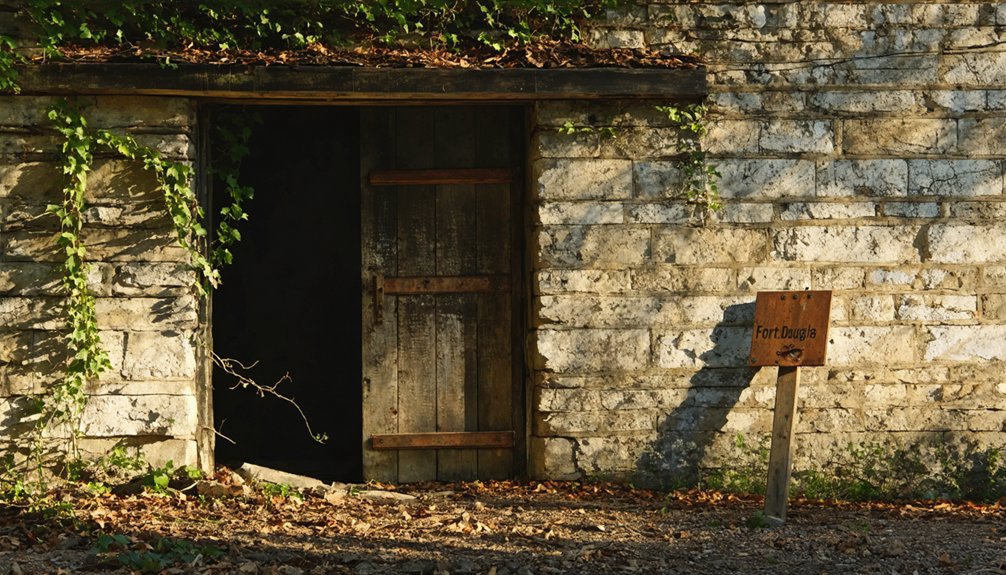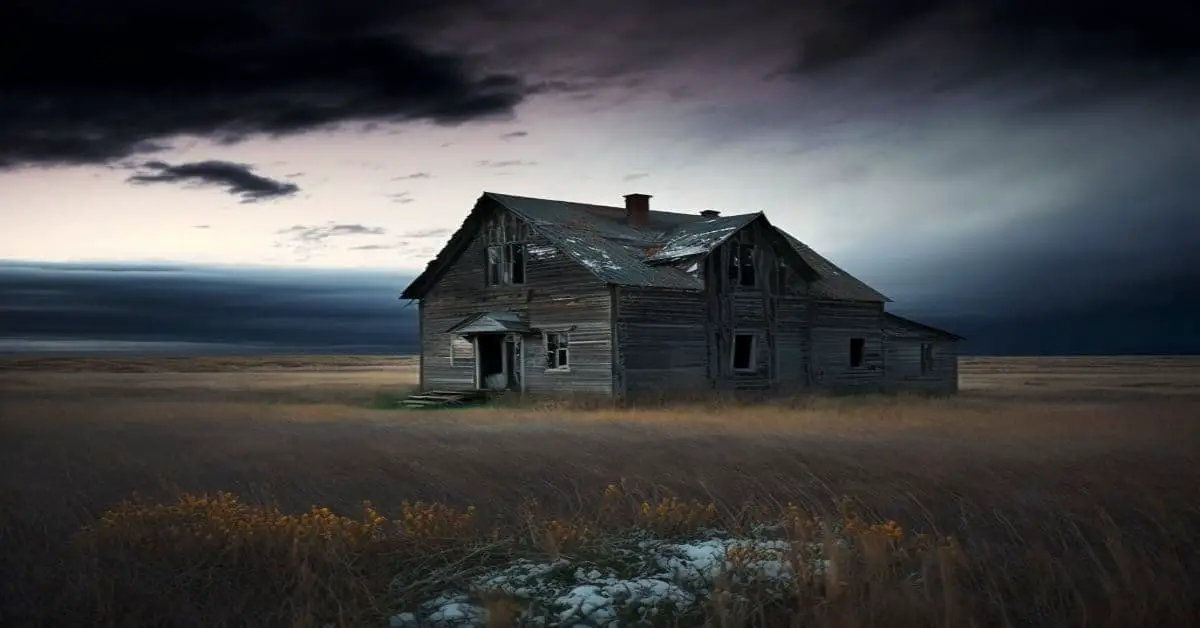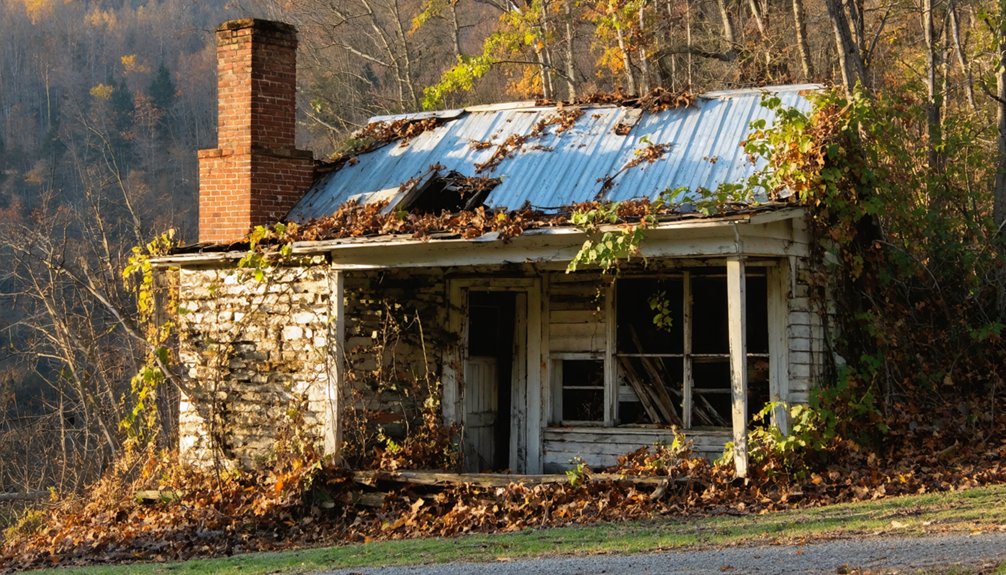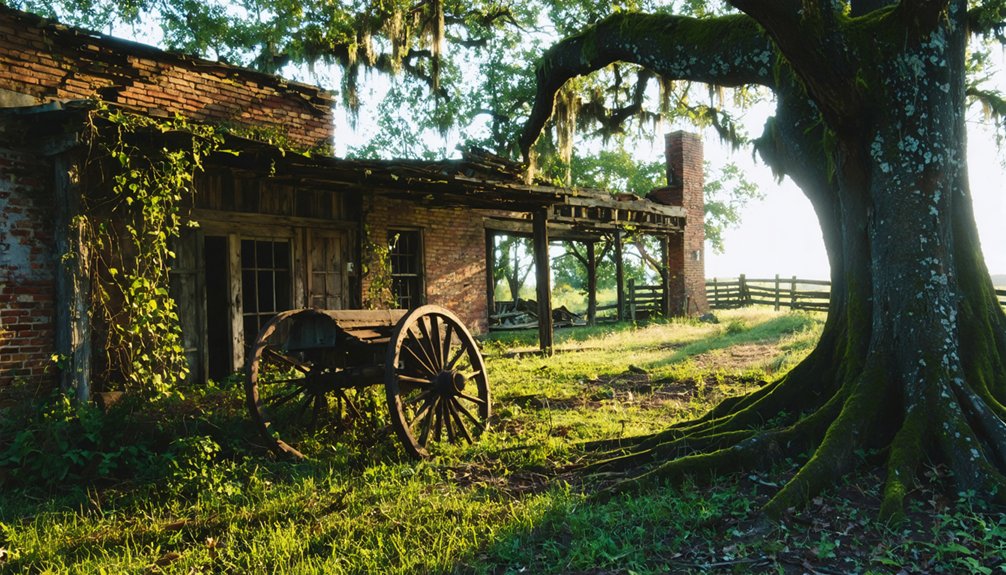You’ll find Fort Douglas nestled in Arkansas’s rugged Ozark Mountains, where it began as a small farming settlement in the mid-1800s. The community centered around subsistence agriculture, with families raising livestock and tending crops while building essential structures like a post office, general store, and school. Today, only Douglas Cemetery with its 362 burials remains after the town’s annexation by Highfill. The site’s rich history of frontier life and community resilience holds many untold stories.
Key Takeaways
- Fort Douglas was a farming settlement in Arkansas that later became a ghost town after annexation by the nearby town of Highfill.
- The community centered around subsistence agriculture, with families raising livestock and crops along the Arkansas River.
- Local infrastructure included essential amenities like a post office, general store, school, and the historic Douglas Cemetery.
- The arrival of natural gas service in the 1950s brought minimal development before the town’s eventual abandonment.
- Douglas Cemetery, containing 362 burials, remains as the primary preserved remnant of the former settlement.
Origins and Historical Context
While the exact establishment date of Fort Douglas remains unclear, this Arkansas ghost town reflects the broader pattern of settlement and abandonment that characterized many communities in the state’s history.
Like many founding myths of Arkansas settlements, the town’s story is intertwined with the region’s military and territorial development, similar to established outposts like Fort Smith and Fort les Arcansas.
Fort Douglas echoes a familiar pattern in Arkansas history, where military outposts laid the groundwork for frontier settlements and territorial expansion.
You’ll find that settlement patterns in this area were heavily influenced by Arkansas’s diverse geography and access to water resources, much like the early development of Monte Ne which was built near what would become Beaver Lake.
Just as with Hopefield, which was established by Benjamin Foy in 1795, Fort Douglas emerged during a time of shifting territorial control and development.
The challenging topography and environmental conditions shaped how communities like Fort Douglas developed and ultimately declined.
As with many ghost towns in the state, economic shifts, natural disasters, and changing social dynamics likely contributed to its eventual abandonment, leaving behind a monument to the state’s dynamic past.
Life in Early Settlement Days
As early settlers established themselves in Fort Douglas, they quickly developed a self-sustaining community built around agriculture and local trade. You’d find families working together to raise livestock and tend crops along the Arkansas River, while blacksmiths and carpenters set up essential services throughout the settlement.
Community gatherings were the heartbeat of Fort Douglas, where you’d experience traditional music, storytelling, and seasonal festivals that brought everyone together. The settlement’s history was shaped by the Trail of Tears that passed through the area in the late 1830s.
The town’s agricultural practices adapted to face harsh weather conditions and wildlife threats, with settlers sharing resources and knowledge to overcome these challenges. Local infrastructure grew steadily, with the construction of a post office, general store, and school serving as anchors for daily life.
The nearby military presence added another layer of cultural diversity to this frontier settlement. The volunteer forces from California and Nevada provided protection for the surrounding region.
Military Significance and Development
You’ll find that Fort Douglas didn’t actually exist in Arkansas – there’s a historical error in the article title, as Fort Douglas was established in Utah Territory in 1862.
During the time when Fort Douglas was active, Federal troops in Arkansas worked extensively to construct defensive earthworks near Fort Smith under Major-General Samuel R. Curtis.
At this strategic location in the foothills east of Salt Lake City, Union volunteers from California and Nevada maintained control over the Overland Mail route while monitoring Mormon activities.
The fort’s early garrison life centered around its role as headquarters for the District of Utah in the Department of the Pacific throughout the Civil War, with troops conducting regular patrols and training exercises. Originally commanded by Colonel Patrick E. Connor and manned by the 3rd California Volunteers, the fort would later transition to Army regulars by 1866.
Early Garrison Life
During the early days of Fort Douglas, Colonel Patrick E. Connor established a unique garrison culture with volunteer regiments from California and Nevada rather than regular army troops.
You’d have found these soldiers spending their days conducting military drills and standing sentry duty, while also pursuing prospecting ventures in the nearby mountains – a distinctive blend of military and economic activities. Similar to the Arkansas Post garrison established in 1721, the fort played a crucial role in protecting regional trade interests.
Soldier interactions were shaped by the fort’s isolation and frontier conditions, much like those at the Tower Building which served as a munitions warehouse.
You would have seen troops adapting to life in rudimentary barracks with limited amenities, relying heavily on local resources for survival.
Their daily routines centered on maintaining military readiness while maneuvering through the challenges of their remote posting, always prepared for potential unrest in the politically sensitive Utah Territory.
Note: There appears to be an error in the article title, as the facts clearly indicate this is about Fort Douglas in Utah, not Arkansas.
Training and Operations
Fort Douglas emerged as a vital military stronghold in 1862, tasked with protecting both the overland mail route and key telegraph lines across the Utah Territory.
Initially a small camp, it grew into a regimental post by 1878, strategically positioned near the Transcontinental Railroad to enhance its operational flexibility. Like Fort Pickett in Camden, Fort Douglas utilized earthwork fortifications for defensive positioning.
You’ll find the fort served multiple roles throughout its history, functioning as the District of Utah headquarters during the Civil War. Similar to Arkansas facilities during World War II, the fort processed over 23,000 POWs through its gates.
Its extensive training facilities included rifle ranges, skeet ranges, and obstacle courses, supporting military exercises for forces across Utah, Idaho, and Montana.
The fort’s adaptability became evident during World War I when it transformed into an internment camp for German Americans and POWs, demonstrating its vital role in national defense and regional security operations.
Notable Residents and Local Stories
You’ll find that many of Fort Douglas’s pioneer families left behind complex legacies, though specific details have been lost to time.
The daily rhythms of life in this Arkansas settlement reflected the broader patterns of Ozark Mountain communities, where families worked together to maintain farms and small businesses.
While concrete records of individual stories remain scarce, oral traditions suggest that Fort Douglas’s residents faced the typical challenges of frontier life, from harsh winters to the gradual economic changes that eventually led to the town’s decline.
Pioneer Family Legacies
In the heart of early Arkansas settlement, pioneering families laid the groundwork for what would become Fort Douglas’s rich historical legacy. Through family migrations from across the country, settlers like the Douglases brought their pioneer traditions and determination to build a thriving community.
You’ll find their impact woven into every aspect of the area’s development, from the establishment of farmlands to the creation of essential community spaces.
These families didn’t just settle the land – they shaped it by building roads, establishing schools, and setting aside ground for sacred spaces like the Douglas Cemetery.
Their stories of perseverance through harsh weather, difficult terrain, and the challenges of frontier life continue to inspire current generations and strengthen the community’s identity.
Daily Life Stories
Life in Fort Douglas revolved around the demanding rhythm of zinc mining, where families like the Baldridges, Goodalls, and Seays formed tight-knit bonds through shared experiences of hard work and perseverance.
Daily routines centered on mining shifts, while community gatherings at the local church and post office provided essential social connections.
Through oral histories, you’ll discover stories of resilience passed down through generations of mining families who called this Ozark town home.
- Multi-generational miners shared tales of underground challenges, workplace accidents, and the camaraderie that helped them survive.
- Community gatherings marked important milestones, from mining successes to holiday celebrations.
- Families adapted to life without modern amenities, relying on wood stoves and outdoor plumbing while building lasting friendships.
Economic Rise and Decline

Fort Douglas’s economic story began modestly in the mid-19th century as a small farming settlement centered around the Douglas family homestead.
Early settlers focused on basic subsistence agriculture, clearing land and raising livestock to support their families. Economic factors remained limited, with no significant commercial ventures beyond essential farming activities.
You won’t find tales of bustling industry or mining booms here. The town’s slow population trends tracked with minimal developments, most significantly the arrival of natural gas service in the 1950s.
While incorporation in 1958 brought some infrastructure improvements, Fort Douglas never diversified beyond its agricultural roots.
The cemetery’s growth – reaching 362 burials – tells the story of steady but modest community expansion.
Eventually, annexation by nearby Highfill and the area’s airport development sealed the town’s fate, leaving only the historic Douglas Cemetery as its economic legacy.
Geographic Location and Natural Features
Nestled within the rugged Ozark Mountains of northwest Arkansas, Fort Douglas occupies a distinctive location near the scenic Buffalo National River. The topographical features include limestone-rich terrain with steep hills, dense forests, and scattered clearings where the town once thrived.
You’ll find a network of springs and streams that highlight the area’s hydrological significance, feeding into the pristine Buffalo River.
- The site’s mixed hardwood forest showcases native oaks, hickories, and pines, with seasonal wildflowers and historic daffodils marking former homesteads.
- Natural karst formations create unique caves and sinkholes throughout the surrounding landscape.
- The humid subtropical climate supports diverse wildlife while contributing to the natural preservation and decay of remaining structures.
Preservation Efforts and Current Status

Despite its historical significance, preservation efforts at Fort Douglas now center primarily on the Douglas Cemetery, which contains 362 burials dating back to the pre-Civil War era.
You’ll find preservation challenges including natural deterioration, limited burial space, and development pressures from surrounding pasturelands.
Community involvement has proven essential, with local heritage organizations leading advocacy efforts for historic recognition. They’ve successfully nominated the 3-acre cemetery for the Arkansas Register of Historic Places under Criterion A.
The site’s archaeological value lies in its remaining Douglas homestead cellar and potential subsurface features, though no major fort structures still stand.
Since Highfill’s 1995 annexation of the area, preservation partnerships between municipal authorities and historical societies help protect this proof of early Arkansas settlement.
Legacy in Arkansas History
As one of Arkansas’s earliest frontier outposts, the legacy of Fort Douglas extends far beyond its original military purpose. You’ll find its influence woven into the region’s cultural heritage through the Douglas family’s pioneering settlements and the strategic location that shaped early trade routes.
The site’s historical memory lives on through the Douglas Cemetery, where both early settlers and Confederate soldiers rest, telling stories of resilience and community formation.
- The fort’s remains serve as a reflection of Arkansas’s shift from frontier defense to settled communities
- Archaeological artifacts and cemetery structures provide tangible links to pioneer life
- Local traditions and commemorations continue to honor Fort Douglas’s role in shaping regional identity
Today, you can trace the fort’s impact on Arkansas’s development through surrounding farmlands, settlement patterns, and enduring family histories that define the area’s character.
Frequently Asked Questions
Were There Any Documented Native American Conflicts Near Fort Douglas?
You’ll find documented native tribes engaged in Civil War conflicts throughout Arkansas, including battles at Pea Ridge and Prairie Grove, which impacted the conflict history near Fort Douglas’s region.
What Natural Disasters or Epidemics Impacted the Fort Douglas Community?
You won’t find specific records of flood damage or disease outbreaks at Fort Douglas. While frontier settlements faced typical 19th-century health risks and natural disasters, there’s no documented evidence of major catastrophes impacting this community.
Did Any Famous Outlaws or Bandits Pass Through Fort Douglas?
While you’ll hear tales of regional outlaws like Belle Starr and Jesse James, there aren’t any confirmed outlaw sightings or documented bandit encounters specifically at Fort Douglas in historical records.
What Crops or Livestock Were Primarily Raised by Fort Douglas Settlers?
You’ll find settlers focused on cotton as their main cash crop, while growing corn for sustenance. Their crop diversity included vegetables, and their livestock management centered on mules, horses, and cattle.
Were There Any Local Legends About Hidden Treasure in Fort Douglas?
You won’t find any treasure maps or ghost stories about hidden riches at this site. Historical records, archaeological evidence, and local folklore don’t support any claims of buried treasure.
References
- https://www.youtube.com/watch?v=oCM_x7-ymS0
- https://arkansasfrontier.com/ghost-towns-in-arkansas/303766/
- https://kkyr.com/have-you-ever-been-to-this-old-abandoned-ghost-town-in-arkansas/
- https://www.arkansasheritage.com/arkansas-register/douglas-cemetery
- https://www.youtube.com/watch?v=U7UCuISy_GY
- https://ozarkmountainhiker.com/tag/ghost-town/
- https://en.wikipedia.org/wiki/List_of_ghost_towns_in_Arkansas
- https://www.youtube.com/watch?v=s2a3hAf5d-Y
- https://www.northamericanforts.com/West/ar.html
- http://freepages.rootsweb.com/~gtusa/history/usa/ar.htm



